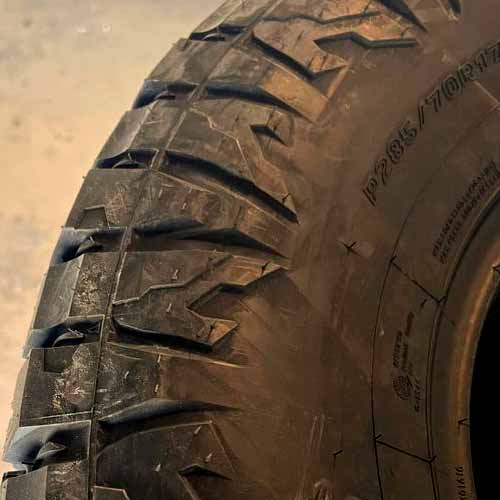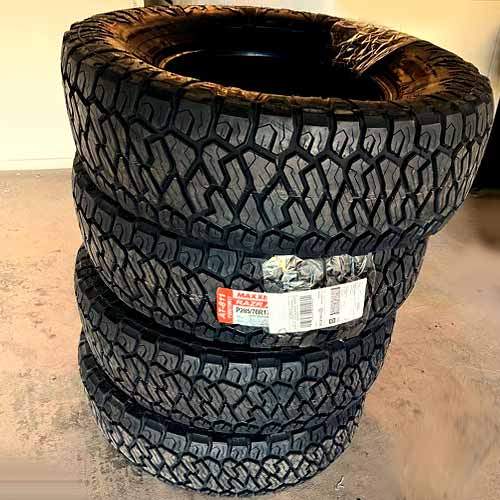The Maxxis Razr AT811 is a very aggressive looking hybrid tire. A “hybrid” may make you think of Prius, but here in the tire world, its a mixture of two different tires, so in case of Maxxis Razr AT811, the tire offers shoulders of a mud terrain tire, combined with closed up central blocks of all terrain.

The Maxxis Razr AT811 offers a very durable 3 ply polyester construction and has wider outer channels, which are capable of self cleaning in mud. On roads, the tire does okay in dry, however needs improvement in wet traction, but its a compromise you make when picking a such aggressive category. But the tire really makes up for it, with its impressive performance on rocks.
Side Note: If you haven’t checked out my list of top all terrain tires, I’d recommend you do that first.
Tire Sizes:
Let’s get tire sizes out of the way first, the Maxxis Razr comes in 15 to 24″ total sizes where in 15 inches, only 31X10.50R15LT is available with load rating of C.
In a similar way the biggest size, 24″ is also only available in 37X13.50R24LT with load rating of F.
Most sizes are in 18 and 20″, and overall you are going to see tread depth of 15/32″ (where a few have 12/32″ as well).
To give you an idea, the tread depth of 15/32″ is similar to BF Goodrich KO2 (review).
All of it’s sizes are 3 peak mountain snowflake rated so they are going to be great on snow but more on this later.
Tread Appearance:

Tire looks very aggressive.
The 4 blocks together make Z shaped grooves which connect with the outer longitudinal channels.
All central blocks have rectilinear siping including the shoulder blocks but on shoulders you also see deep biting edges in the form of cuts.
These provide extreme grip off road especially on rocks.
These blocks are staggered and they make very wild outer sidewall lugs which help this tire a lot on rocky terrains.
It’s lugs are also thick enough to provide this tire protection from sharp off road thorns or rocks.
Durability:
The inner casing of the tire has 3 layers of polyester, which makes 3 ply sidewalls for this tire. And I should add that this structure suits it’s aggressive design.
The casing has 2 more layers of steel belts running on top. These are then covered with a single layer of nylon, which is below average as most tires offer 2 ply nylon caps on top, but still the rubber of the tire is chip and cut resistant so it’s not an issue here.
Overall, Maxxis Razr AT811 is tough enough and confidence inspiring when you take them on rugged terrains.
On Road Performance:
On highways, the performance is mostly judged by 3 main things: the tire’s cornering abilities (lateral traction), the response of the tire with steering and overall stability especially while braking.
Due to aggressive design of all terrain tires, these factors are not going to be as impressive as a touring tire for example, and having said that, the Maxxis Razr provides a good balance here.
Dry Traction:
On dry pavements, the Maxxis Razr AT811 seems to have no issue, as it offers quite some rubber to road contact, as nothing much is going on on its lugs, mostly there aren’t any traction notches eating away the rubber space.
The tire is also relatively softer, so it better able to stick on roads and provide ample traction.
Overall these tires are pretty reliable, their dry performance remind me of Toyo RTs.
The staggered shoulder blocks with deep biters provide good amount of lateral stability. It communicated well with the steering, although at 45 mph+, you really start to feel them.
Wet Traction:
Wet performance is not very impressive on Maxxis Razr AT811. The tire does not offer a lot of sipes to begin with. And on top of that, these sipes although are full depth, don’t provide a wave like pattern which provides stability (as such sipes interlock within).
With heavy internal structure, and big lugs, the tire offers poor response on corners. The wide lateral grooves between the blocks also minimizes rubber to road contact by a good margin.
But still the softness of the tire’s compound helps a little bit. The sipes are still flexible enough to give some sort of traction, but I would not recommend you drive these tires without traction control off.
Hydroplaning:
When it comes to hydroplaning, also known as aquaplaning, it depends on the tires ability to evacuate water from its channels, so it would not float.
And this tire with it’s wide aggressive grooves provide massive water evacuation capability, so you are going to get decent float speeds with them both on straight and on curves.
For folks who don’t know, float speed is just a maximum speed with which a tire can move on standing water without floating.
Snow Performance:
Snow itself has a lot subcategories. There is on road snow, then there is deep snow, and of course, ice, all these provide different terrain challenges.
The good thing about Maxxis Razr AT811 is that it has 3 peak mountain snowflake rating, which is an acceleration test on snow, so no problem there.
For Your Info: The 3pmsf rating is often mistaken as a braking or handling test, where it just shows you that the tire has better acceleration values on snow compared to an average all season tire.
But still the Razr AT also shows very acceptable braking distances, exhibiting nice griping, and it’s handling is also optimized.
Running them on snow makes you think their shoulders are more optimized for this type of terrain then on wet. That’s why these tires don’t do so well on ice. An option of being stud-able would have made them better, as the biters on the tire is not enough to grip the slippery icy surface.
If we talk about deeper snow, up to 2 feet, it’s not much of a challenge for this tire.
It’s tread depth reaches up to 15/32″ which is ample given how wide it’s grooves are. They easily evacuate, ice/water/slush out.
It’s staggered shoulder blocks with mud scoops also help with deeps snow, where they and sidewall biters combined provide decent forward momentum, by throwing snow backwards.
Tread Wear:
The Maxxis Razr AT811 with it’s softer compound would wear a little faster compared to other less aggressive all terrain tires out there. But the tire still offers cut resistant rubber and a good tread depth which is going to last a while.
The tire also keep things lighter by not giving extra nylon cap ply. It gives you 50k miles warranty (on LT sizes).
Speaking form experience if you rotate these tires religiously after every 4 to 5k miles, and you take them 50/50 on and off road, you are going to get 40k plus miles out of them.
For Your Info: Out of all AT tires I’ve reviewed, I’ve found General Grabber ATX to do best in terms of tread wear.
Ride Quality:
Tire’s aggressiveness is inversely proportional to it’s ride quality. That’s why the most comfortable out there are passenger tires which aren’t meant for off road.
In the middle comes all terrain, and the most aggressive of all, mud terrain tires provide the least amount of ride quality of all.
Now in case of Maxxis Razr AT811 these tires actually are coming in between all terrain and mud terrain, and although not marketed that way, they are hybrid, so they take the middle route here.
Now, having said that, let’s discuss it’s noise and comfort.
Comfort and Noise:
If we talk noise first, the Maxxis Razr AT811 offers variable pitches, which is mostly seen nowadays with many AT tires, some call it variable pitch technology, others like Maxxis calls it multi-pitch, they all provide a same mechanism.
Noise is just air hitting the tread. And on Razr AT811, the blocks vary a little in size from each other as they move down the tread. This variations produces different frequencies of sounds which try to cancel each other out, dampening the noise.
Still these tires are going to be noisier than your average all terrain tire, but not louder than mud terrain.
If we talk comfort, the softer rubber of the tire does a good job absorbing the impacts. Usually with 3 ply polyester construction, tires get stiffer, but Maxxis Razr AT811 has a single nylon cap ply where they are 2 usually, and this way it still keeps your ride some what comfortable to imperfections of the road.
For Your Info: Most comfortable all terrain tire in my experience is the Yokohama Geolandar G015.
Muddy Terrain Performance:
The Maxxis Razr AT811 with mud terrain outer lugs, is very capable on this type of terrains. The tire’s performance in fact reminds me of Goodyear DuraTrac, (compared with BFG KO2) which offers amazing mud traction.
Mud to mud contact is not what you want here, so a tire ideal for muddy terrain should be able to self clean it’s grooves, and it must have a larger tread depth combined with big traction scoops on shoulder blocks.
Luckily, Maxxis Razr AT811 has all these features. The tire offers wider grooves which connect laterally with each other and help in escaping the mud. It offers 15/32″ which is although not too much, still gets the job done, and it’s staggered shoulder blocks provide you with mud scoops and these with sidewall lugs gets the tire out even when deep in mud.
Rock Traction:
Personally, I am impressed with Maxxis Razr AT811’s performance on rocks. They provide phenomenal rock crawling abilities.
Out of all the hybrid tires I’ve reviewed, the best ones on rocks so far are Nitto Ridge Grappler, Mickey Thompson Baja Boss AT (review), and then Maxxis Razr AT811, I’d rate all these tires equal in terms of traction.
And by traction I mean everything, lateral stability, sidewall lugs gripping power, climbing ability, on both dry and wet conditions.
The sidewall lugs of these tires are very impressive. They stick!
Just drop pressure to a lower PSI, depending on your size, and watch these puppies go. It’s sidewalls won’t let you down.
Sand Traction:
Sand is the terrain where you need very less footprint and more rubber. In other words, the tire with most gaps between the tread blocks would perform better here. That’s why there are paddle or balloon tires dedicated for this type of terrain.
The good news is, the tire’s lugs provide a good rubber to sand contact when aired down.
Airing down the tire can give you good results. But make sure the rim protectors stays in tact.
Maxxis Razr tires keep it’s section width smaller so it’s not going to be too much of a problem. As a wider wheel is more prone to the bead rolling off the tire.
Things to keep in mind:
The Maxxis Razr AT811 is going to perform much better off road than on highways. But the tire is still good enough for roads. There are not too loud, provide satisfactory ride quality, all is good except their wet handling. It’s a little below average.
Other than that, the snow traction is a plus for this tire and it comes with 3 peak mountain snowflake rating, which authenticates it.
Mud performance is very considerable and it’s traction on rocks is simply amazing.